![]()
![]()
![]()
Use LEFT and RIGHT arrow keys to navigate between flashcards;
Use UP and DOWN arrow keys to flip the card;
H to show hint;
A reads text to speech;
83 Cards in this Set
- Front
- Back

|
1. St. Francis Preaching to the Birds, Basilica of San Francisco, Assisi 2. Giotto 3. fresco 4. early Renaissance, Italy 5. revives narrative in art, shows the importance of gesture as a means of expression |
|

|
1. The Lamentation, Arena Chapel, Padua 2. Giotto 3. Fresco 4. Early Renaissance, Italy 5. reversed composition (right to left), emphasizes movement downward towards earth/death, background and figures in space, imposes viewer into scene through privileged view, showing figures from back through drapery, lower focal point than usual, implies resurrection with movement toward budding tree. |
|

|
1. Christ Entering Jerusalem 2. Giotto 3. fresco 4. Early Renaissance, Italy 5. gives form and strong 3D shape in fabric, innovation in 3D space in the overlapping of people and halos, importance of gesture and movement, giornata: in a days work, creating a background |
|

|
1. Merode Altarpiece Triptych 2. Robert Campin 3. oil on panel 4. Early Renaissance, North 5. small piece for a private setting, figures are hierarchically large, white lilies are symbol of the virgin, left side: patrons have privileged view of the divine moment of the impregnation of Mary, modern setting of old religious moments/ traditional Flemish home, mousetraps warding off evil, book open to page it represents |
|

|
1. Man in a Red Turban (Self Portrait) 2. Jan Van Eyck 3. oil on panel 4. Early Renaissance, North 5. shows self confidence about painting abilities, purpose is to show how he is the best a painting, eye contact with viewer is somewhat new, self portrait has no commercial worth, new idea of secular painting, eye contact and engagement with the viewer, rise of artist as genius |
|

|
1. Arnolfini Wedding 2. Jan Van Eyck 3. oil on panel 4. Early Renaissance, North 5. specific features designate subject, 3 oranges: trinity, formal gestures/formulaic, dog=symbol of fidelity, signature on mirror=innovation, symbolism in Flemish art, shoes off sacred ground, secular painting with religious influence, natural window light=symbol of divine |
|

|
1. Garden of Earthly Delights 2. Hieronymous Bosch 3. oil on panel 4. Early Renaissance, North 5. looking at whole of humanity, viewer in position of all seeing eye/godlike position, illustrates diversity of Renaissance, use of imagination, one of first artists to title his work, reference to fruit is god's creation/decay, influence of alchemy |
|

|
1. St. George, Orsanmichele, Florence 2. Donatello 3. marble sculpture in the round on top of relief panel 4. Early Renaissance, Italy 5. boyish, youthful saint shown by small figure, body mirrors shield, icon/guardian figure of Florence, relief depicts his most famous deed, youthfulness reminiscent of Doryphorus |
|

|
1. Gattamelata 2. Donatello 3. bronze sculpture in the round 4. Early Renaissance, Italy 5. signed in Latin on bottom-->conscious of his own ability/masterpiece and shows him as a scholarly intellectual, artist as genius and self confident age, equestrian statues were for emperors previously |
|

|
1. David 2. Donatello 3. bronze statue in the round 4. Early Renaissance, Italy 5. question of more Christian or Pagan because he's eroticized and nude, beholder's share becomes more, rise of independent artistic thought, significant contrapposto, slight ambiguity of sex, private piece for Medici family, bronze shows expense and need for patron |
|

|
1. The Holy Trinity, Santa Maria Novella, Florence 2. Masaccio 3. fresco 4. Early Renaissance, Italy 5. believable perspective, mimics perspective of building its in, making reality of religious figures, painted image as extension of real space, donors on sides, "clothed nudes" improvement on Giotto, while sculptural forms show his influence, deep picture space independent of figures, one of the first paintings to take on perspective |
|

|
1. The Tribute Money, Brancacci Chapel, Florence 2. Masaccio 3. fresco 4. Early Renaissance, Italy 5. not sequential ordering, more elaborate from Giotto distance created by atmospheric perspective, establishing importance of gesture in art, innovative in breaking up of composition into 3, most famous statue in chapel, reading isn't left to right shows thoughtful way to depict narrative, intense glances and interactions aid narrative |
|

|
1. Expulsion from the Garden of Eden, Brancacci Chapel, Florence 2. Masaccio 3. Fresco 4. Early Renaissance, Italy 5. innovative in representation of less beautiful reality, sculptural weight to figures influenced other artists, significant use of gesture and what it conveys |
|
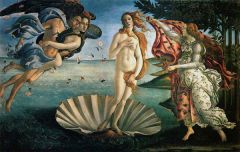
|
1. The Birth of Venus 2. Botticelli 3. tempera on panel 4. Early Renaissance, Italy 5. first celebrated female nude not in religious setting since classical antiquity, imaginary figure, emphasis on outline makes it look floaty, shows ancient influence |
|

|
1. Vitruvian Man 2. Leonardo DaVinci 3. pen and ink 4. High Renaissance, Italy 5. Religion-->humanism, man as a measure of all things |
|
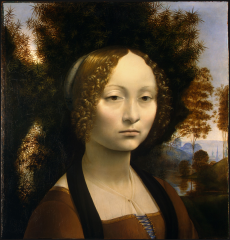
|
1. Ginevra de' Benci 2. Leonard Da Vinci 3. oil on panel 4. High Renaissance, Italy 5. sfumato: smoky, delicate, light/dark transitions, plucked eyebrows and high forehead show intelligence, depicted outdoors and not in profile in a simple dress which are very new ways to paint a female portrait, atmospheric perspective |
|

|
1. Mona Lisa 2. Leonardo Da Vinci 3. oil painting 4. High Renaissance, Italy 5. first painting to be a media star, famous because of painter instead of subject, "leaning out" of picture to engage us, subject's identity defines picture, set outdoors=unconventional, innovation in motion within subject, engages viewer in expression, mastering of oil technique through thin glazes |
|

|
1. The Last Supper, Santa Maria delle Grazie, Milan 2. Leonardo Da Vinci 3. tempera wall mural 4. High Renaissance, Italy 5. start of thinking of artworks as works of genius, causes us to question ourselves as a betrayer of Christ, power of gesture is shown through personality and each figure's relationship with Christ, different emotion/reaction in gestures, innovative experimental nature in rejecting fresco technique, Leonardo's process and decisions support artist as genius |
|

|
1. David, Florence 2. Michelangelo 3. marble sculpture in the round 4. High Renaissance, highly 5. not a narrative representation of the bible, unique work of art, complete nudity is more pagan than Christian, "manu fortis"=strong of hand, Florence took it as an emblem of republican values, figure not treated as victorious hero but as an ever vigilant guardian of the city, penetrating stare implies second figure, influence of Roman Hellenistic nudes, influenced by Donatello's David |
|

|
1. Pietá 2. Michelangelo 3. marble sculpture in the round 4. High Renaissance, Italy 5. internalized sorrow, presenting body to viewer, established Michelangelo as famous name, shows influence of northern artwork in which Pieta was more known as a theme, oversized virgin echoes theme of madonna and child |
|

|
1. Sistine Chapel, Vatican City 2. Michelangelo 3. fresco 4. High Renaissance 5. series of images from the book of Genesis (creation of the world) Michelangelo's own depiction, first fresco |
|

|
1. Creation of Adam, Sistine Chapel 2. Michelangelo 3. fresco 4. High Renaissance, Italy 5. first fresco he ever painted, imaginative visualization, shows the power of gesture, Adam looks vacant, waiting for God to impart life, tension created by being so close, nobody really depicted god previously |
|
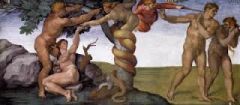
|
1. The Fall and Expulsion from the Garden of Eden, Sistine Chapel, Vatican City 2. Michelangelo 3. fresco 4. High Renaissance, Italy 5. Eve goes from young and virginal-->falling into sin, one of the first pieces that insinuates Adam's fault, influence of Hellenistic antiquity in figures and weight in paintings, improvement from Giotto |
|

|
1. Libyan Sibyl 2. Michelangelo 3. fresco 4. High Renaissance, Italy 5. not a very plausible pose, but shows knowledge of how body works, pagan, prophetess, creating more human than reality through musculature, bodily contortion made beautiful |
|

|
1. School of Athens, Stanza della Segnatura (room of the signatures), Vatican City 2. Raphael 3. fresco 4. High Renaissance, Italy 5. original audience would be knowledgable of philosophers on wall, regarded as Raphael's masterpiece, represents a summation of the high renaissance ideals of humanism, Plato points up to ideal world, Aristotle points down to room of observation, part of a series of disciplines: philosophy |
|

|
1. The Tempest 2. Giorgione 3. oil on canvas 4. High Renaissance, Italy 5. artist inventing things/putting it on us to find meaning, shows what Giorgione is most known for--> mysterious scenes, setting a mood rather than narrative as a means for art, capturing a transient moment of meteorological specificity, |
|
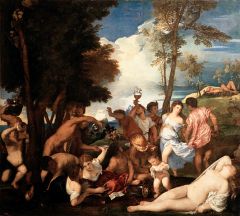
|
1. Bacchanal of the Andrians 2. Titian 3. oil on canvas 4. High Renaissance, Italy 5. invitation to partake, confronts us with physicality, theme is a river of wine, Pagan subject, revisits interest into the past, feels the warmth and breeze from way its painted, realization of ancient myths as part of the natural world |
|

|
1. Man with a Blue Sleeve 2. Titian 3. oil on canvas 4. High Renaissance, Italy 5. one of the most famous portrait artists after Raphael, showing off his skill in creation of fabric, signature shows rise of artist as creator and genius, specificity of face |
|

|
1. Self Portrait, Germany 2. Albrecht Dürer 3. oil on panel 4. High Renaissance, North 5. shows self confidence in his greatness, proclamation of skill, showing of wealth in fur, emphasis on hand=intellect with skill, artists treated as lowly craftsmen in Germany, declaration of genius rendering artists as divine creators/ godlike shown in frontal view and long hair, Latin writing shows intellect |
|

|
1. Young Hare 2. Durer 3. watercolor 4. High Renaissance, North 5. almost photographic accuracy, |
|

|
1. Melencolia 2. Durer 3. Engraving, intaglio: carved into metal plates, ink is left in marks 4. High Renaissance, German 5. allegorical self-portait, shows imagination and creativity |
|

|
1. The Four Horsemen of the Apocalypse 2. Durer 3. woodcut 4. High Renaissance, North 5. most ambitious work, entrepreneurial spirit through uncommissioned, sets standard for woodcut technique |
|

|
1. The Blind Leading the Blind 2. Brueghel 3. oil on panel 4. High Renaissance, Dutch 5. illustrates the biblical proverb: the blind the blind will fall into a ditch-->downward composition, church indicates how religion hasn't helped them, proverbial characteristic of Dutch literature |
|

|
1. The Peasant Wedding 2. Bruegel 3. oil on panel 4. High Renaissance, Dutch 5. characteristic interest in the lower class, purposeful chaos, even lower class is worthy of depiction as opposed to high class previous portraits |
|

|
1. The Return of the Hunters 2. Bruegel 3. oil on panel 4. High Renaissance, Dutch 5. rise in importance of landscape, depiction of lower class, inaccessible village, human activity fully integrated into landscape |
|

|
1. Self Portrait as the Allegory of Painting 2. Artemesia Gentileschi 3. oil on canvas 4.Baroque, Italy 5. shows painting is a physical act but also one of intelligence, allegorically reflecting on her role as a woman painter, well dressed, elevated status |
|

|
1. Judith Slaying Holofernes 2. Artemesia Gentileschi 3. oil on canvas 4. Baroque, Italian 5. raises biological fallacy of her rape, immediately implicates viewer in scene |
|

|
1. The Rape of Danae 2. Artemisia Gentileschi 3. oil on canvas 4. Baroque, Italy 5. mythological rape where Zeus impregnates her with a shower of gold |
|

|
1. David and Goliath 2. Bernini 3. marble sculpture in the round 4. Baroque, Italy 5. coming of age masterpiece, ropes of delicate marble shows Bernini's skill, new active relationship with surrounding space |
|
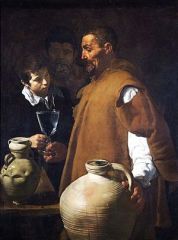
|
1. The Water Carrier of Seville 2. Velasquez 3. oil on canvas 4. Baroque, Spain 5. lowest class/worst job, still life of a human being, contrast of socio economic status, genre everyday portrayal, influence of Caravaggio chiaroscuro |
|

|
1. Las Meninas 2. Velasquez 3. oil on canvas 4. Baroque, Spain 5. makes the viewer question their relationship, very much included in picture, genre portrait, caught in the moment, rise of the artist as genius as putting him in an important place in the painting |
|

|
1. The Jewish Graveyard 2. Jacob van Ruisdael 3. oil on canvas 4. Baroque, Dutch 5. more than just description of the world, gives landscape more importance as art form, emotion of vanitas, rainbow=God's promise of redemption, figures unimportant compared ot landscape |
|

|
1. The Jolly Toper 2. Hals 3. oil on canvas 4. Baroque, Dutch 5. places the viewer closer, instantaneous moment, innovation of abbreviated brushwork, engaged portrait-he interacts with viewer, conversational quality |
|

|
1. Self Portrait 2. Judith Leyster 3. oil on canvas 4. Baroque, Dutch 5. represents herself as an aristocrat, pupil of Hals, she can paint portraits, genre styles, canvas shows what other work she can do |
|

|
1. Self Portrait 2. Rembrandt 3. oil on canvas 4. Baroque, Dutch 5. impasto: thick paint application and visible brushstrokes, penetrating gaze, you see a person instead of a painting |
|

|
1. Blinding of Samson 2. Rembrandt 3. oil on canvas 4. Baroque, Dutch 5. outside light creates sense we're inside the tent, creates cinematic effect, chiaroscuro, biblical subject with high drama, intentional composition, implied participants, shows Rembrandt as master storyteller |
|

|
1. The Night Watch 2. Rembrandt 3. oil on canvas 4. Baroque, Dutch 5. group portrait turned into an action scene, we're immediately and directly implicated in the scene, reinvents idea of a shooting company, solves problem of proportional distances, color used as compositional device |
|

|
1. Oath of the Horatii 2. David 3. oil on canvas 4. French Neo-classicism 5. neoclassism emphasis on great history paintings, goes against commission request shows growing status of artists, line and geometry prevail over brushwork and color, Caravaggio influences |
|

|
1. Death of Marat 2. David 3. oil on canvas 4. French Neo-classicism 5. appropriated religious iconography for secular glorification, understated theme of death, looks like modern reporting but is artist's propaganda, wanted people to sympathize with death, more humble |
|

|
1. Death of Wolfe 2. West 3. oil on canvas 4. Neo-classicism 5. popularized new idea of contemporary history painting, modern martyr, "exotically american", artificial setup |
|

|
1. The Nightmare 2. Fuseli 3. oil on canvas 4. Romanticism 5. escape from rationality(indicated by opium), horse: noble-->ghostlike, open to viewer's interpretation, explores erotic depths of the human mind and shrugs off painting expectation |
|

|
1. El Sueño de la Razón Produce Monstruos 2. Goya 3. aquatint print, combo of etching and resin plate 4. Spanish Romanticism 5. shows invention from imagination, start of artists as imaginers, reaction to period's crises, imagination as fuel for artistic creation |
|

|
1. Family of Charles IV 2. Goya 3. oil on canvas 4. Romanticism, Spain 5. self portrait in background: claiming to be the next great artist after Velasquez, willingness to display faults depicts Spanish culture, parents see themselves in children (beautiful), seeing wealth instead of portrait |
|
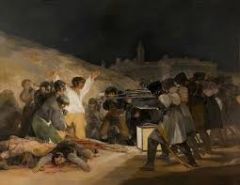
|
1. 3rd of May 2. Goya 3. oil on canvas 4. Spanish Romanticism 5. viewer identifies with victims, more universal understanding of death, close to modern journalism, not just about one execution but the bigger idea of suffering and war |
|

|
1. The Haywain 2. Constable 3. oil on canvas 4. Romanticism, England 5. making landscape into an important achievement, painting as an inquiry into the laws of nature, study of weather |
|

|
1. Hannibal Crossing the Alps 2. Turner 3. oil on canvas 4. Romanticism, England 5. trying to make landscape important by incorporating historical figure, frightening nature compared to tiny people: picturesque vs. sublime, imagination to create sublime feel: inspiring fear |
|

|
1. The Abbey in the Oakwood 2. Friedrich 3. oil on canvas 4. Romanticism, Germany 5. feeling of melancholy, feeling of cold, reduction of human importance, increased power of nature over man, leaves fate after death in doubt: gloomy and unsure horizon, equates nature and religion: God in trees |
|

|
1. The Oxbow 2. Thomas Cole 3. oil on canvas 4. Romanticism, America 5. implied drama in weather, minimal human presence, importance of nature, beginning of America's wild history looking West to tamed landscape, hebrew letters: the Almighty, picturesque vs. sublime |
|

|
1. Raft of Medusa 2. Gericault 3. oil on canvas 4. Romanticism, France 5. close to journalism (recent event), depiction of human misery, conscious composition, figures spilling into our own space, influence of antiquity in figures' poses, death-->hope across diagonal, crossing diagonals |
|

|
1. The Death of Sardanapalus 2. Delacroix 3. oil on canvas 4. Romanticism, France 5. product of his reading: based on Lord Byron's "Sardanapalus," the death of everything, rich and luscious use of paint and color, invented scene, ignores classical space and volume to project moods of destruction, violence, fear and sensuality, departure from exactness from neo-classicism |
|
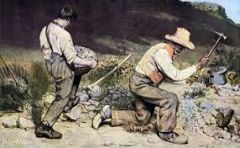
|
1. The Stone Breakers 2. Courbet 3. oil on canvas 4. Realism 5. reacting against romanticism, about socialism and poverty in France, expression of human misery, deliberately political, obscuring of faces turns them into inanimate objects like rocks and tools, unconventional composition with eye jumping all over |
|

|
1. The Third Class Carriage 2. Daumier 3. oil on canvas 4. Realism 5. sympathize rather than laugh at subjects, sense of smell, claustrophobic atmosphere, very modern setting, documenting lower class life, different social conditions displayed through relationships (young mother), fortitude and dignity to figures, compassion of Romanticism |
|

|
1. Calling of St. Matthew, Contarelli Chapel, San Luigi de Francesi, Rome 2. Caravaggio 3. oil on canvas 4. Baroque, Italian 5. oil on canvas unusual because usually churches were painted with frescos, chiaroscuro: sharp and dramatic lighting, religious moment in contemporary clothing, light is most obvious aspect of religion, we're all being called, not just Matthew, spiritual concept through naturalism in common lowlife |
|

|
1. Judith and her Maidservant with the Head of Holofernes 2. Artemisia Gentileschi 3. oil on canvas 4. Baroque, Italy 5. influence of Caravaggio with chiaroscuro, implied participants, raises the question of the biographical fallacy |
|

|
1. Ecstasy of St. Teresa, Cornaro Chapel, Rome 2. Bernini 3. marble statue in the round 4. Baroque, Italy 5. created like theatrical stage setting, incorporates space around it, shows her visionary experience with God, shows "beautiful pain", viewers become part of the "stage" looking at a visionary event |
|

|
1. The Garden of Love 2. Rubens 3. oil on canvas 4. Baroque, Flemish 5. reflects personal changes in his life, reflects architecture of his own home, 6 sisters looking for love, artist making up subject matter, lush and rich romantic tones symbolize end of the baroque, influenced Rococo, painting as a medium to express |
|

|
1. Woman Holding a Balance 2. Vermeer 3. oil on canvas 4. Baroque, Dutch 5. vanitas: beautiful things are transient/ a memorial to the brevity of life, camera obscura: careful study of light as shown by blurred field of vision |
|

|
1. The Slave Ship 2. Turner 3. oil on canvas 4. Romanticism, England 5. literary and historical dimension to landscape--> bigger importance, contemporary history, overall tragic and horrific scene (sublime), people made insignificant compared to nature, power of nature, imagination towards abstraction |
|

|
1. Impression, Sunrise 2. Monet 3. oil on canvas 4. impressionism 5. completely new style of painting, looking like and unfinished sketch yet is signed and dated, aim to catch the fleeting nature of light and color, plein air: painting outside was unusual at the time, time of people being most important subject matter, use of rapid brushstrokes |
|

|
1. Haystacks 2. Monet 3. oil on canvas 4. impressionism 5. exploration of color, no people, dreamlike more than realistic, individual brushstrokes are visible, using color in shadows, |
|

|
1. On the Bank of the Seine, Bennecourt 2. Monet 3. oil on canvas 4. impressionism 5. lack of black, color in shadows, evidence of observation from painting en plein air, not trying to disguise brushstrokes, transient effect of light, quick painting |
|

|
1. The Gare Satint-Lazare Arrival of a Train 2. Monet 3. oil on canvas 4. impressionism 5. confronting with the modern times instead of history, catching immediacy and fleeting effects of light and atmosphere, a piece about dramatic changes of industrialization, visible brushstrokes, blurry pulsating world |
|

|
1. The Luncheon on the Grass 2. Manet 4. impressionism 5. work he did to get into the salon, didn't get in because of new standards, bohemian and incomprehensible, shows control over blues and greens, conscious composition shows influence of Rafael, light canvas brighten colors |
|

|
1. The Orchestra of the Paris Opera 2. Degas 3. oil on canvas 4. impressionism 5. compositionally photographic through arbitrary borders, unusual angle for a painting, sense of continuation beyond scene, shows contemporary life, unusual subject of genre orchestra scene and bassoonist, we feel engaged in a place we usually don't have access, dry brushstrokes show fleeting moment characteristic of impressionism |
|

|
1. A Bar at the Folies-Bergére 2. Manet 3. oil on canvas 4. impressionism 5. innovative in capturing of space through mirror, illusion of more space than exists, barmaid is portrayed as available like the drinks, shows Manet's skill in painting glass |
|
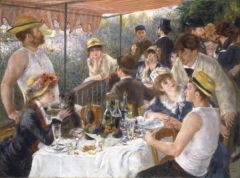
|
1. Luncheon of the Boating Party 2. Renoir 3. oil on canvas 4. impressionism 5. interaction between people, documentation of modern leisure, wet loose brushtstrokes, identifiable subjects |
|

|
1. The Child's Bath 2. Mary Cassatt 3. oil on canvas 4. impressionism 5. influenced by Degas in composition and unusual viewpoint, focus on patterns, domestic scene, regular bathing was a modern phenomenon, depicts emotional and physical involvement |
|

|
1. Mont Sainte-Victoire 2. Cezanne 3. oil on canvas 4. post impressionism 5. breaking down nature in brushstrokes, brushstrokes as deliberate building blocks of the scene, structurally frozen image, doesn't capture the transience of impressionism, overlapping strokes creates sense of depth, clearly a real scene yet clearly a flat painting |
|

|
1. Mont Sainte-Victoire Seen from Bibemus Quarry 2. Cezanne 3. oil on canvas 4. post-impressionism 5. little suggestion of depth despite overlapping of objects, flat surface of brushstrokes and colors, movement towards abstraction as opposed to representation, straying from laws of painting toward license of invention |
|
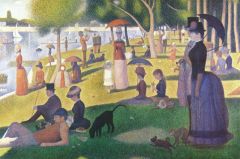
|
1. A Sunday Afternoon on the Island of La Grande Jatte 2. Seurat 3. oil on canvas 4. post-impressionism 5. innovative technique through optical combination of color rather than palette (divisionism), almost no figures overlap, creates sense of more figures, profile, 3/4, frontal, study of the relationships between colors, frozen moment in time, sympathizer with socialist movement conveying utopia of middle class and working class tranquility and leisure, socialist vision of a harmonious perfect world |
|

|
1. The Potato Eaters 2. Van Gogh 3. post impressionism 4. oil on canvas 5. shows compassion for the family and respect for the lower class, focus on faces and lives making them worthy of remembrance, excited expressionism/raw crude energy reflects passion of artist |
|

|
1. The Starry Night 2. Van Gogh 3. oil on canvas 4. Post-impressionism 5. painted while in a mental institution, known for long loose brushstrokes, cypress tree mirrors church steeple, suggesting the link the earth and the transcendental |
|

|
1. The Vision After the Sermon 2. Gaugin 3. oil on canvas 4. Post-impressionism 5. yearned for utopian alternative to advanced civilization, sought out more primitive scene, in Brittany, non naturalistic representation influenced by Japanese prints, influenced by primitive/medieval art instead of higher regarded art, syntheticism: emotional imagination as opposed to representation |

